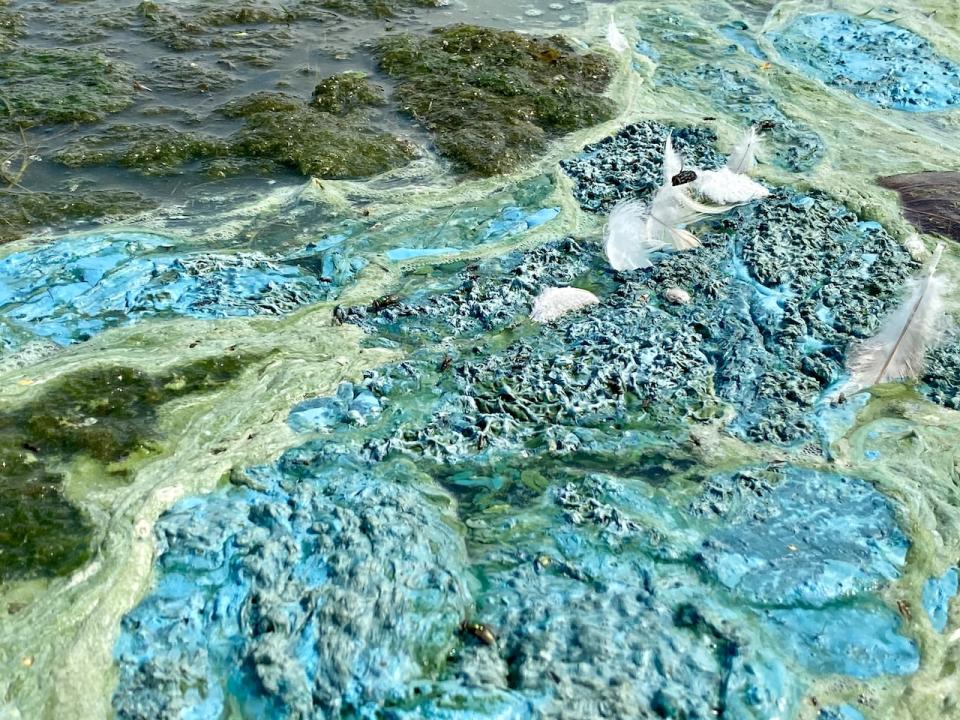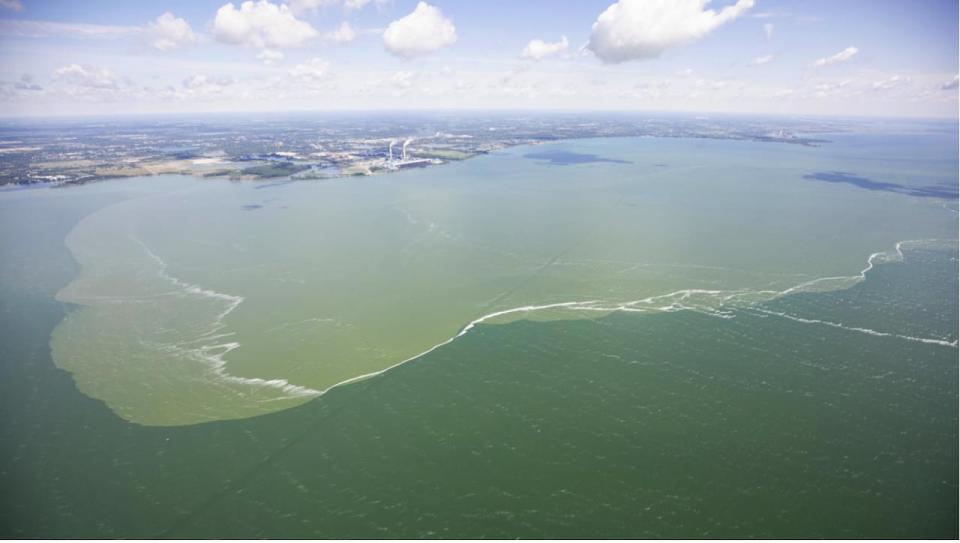Freshwater blue-green algae blooms are “not all bad, and they’re also pretty to look at,” but a Waterloo region researcher is also reminding people that they could be “lethal to humans.”
René Shahmohamadloo, a postdoctoral researcher working at the University of Guelph and Washington State University, says he’s always been passionate about harmful algal blooms, which he describes as “a perfect example” of the relationship between humans and the environment.
“We can be intensively cultivating food to feed a growing population [while] not knowing that these nutrients of nitrogen and phosphorus that might run off into our waters could be impacting a whole range of aquatic life and could be causing cyanobacteria, which is commonly known as blue-green algae, to proliferate in our fresh waters,” Shahmohamadloo told CBC K-W.
Though blooms typically show up in shallow bodies of water with temperatures above 20 C in areas of higher agricultural activity, blooms in colder and more nutrient-poor lakes have been observed more frequently than previously expected.
Blue-green algae and GRCA reservoirs
On Sept. 13 the Grand River Conservation Authority (GRCA) issued an advisory about the presence of blue-green algae in three areas — Belwood Lake, Conestogo Lake and Guelph Lake reservoirs.
Signage has been posted notifying the public of the conditions and the Ministry of the Environment, Conservation and Parks and the Wellington-Dufferin-Guelph Public Health Unit have been notified.


‘The best advice is, if it’s observed, just stay away,’ Irvine says. (Travis Reddaway/CBC)
Cameron Irvine, supervisor of water quality at the GRCA, said the blooms typically occur in the late summer or early fall and have been known to occur on an annual basis at the three reservoirs.
Irvine said the blooms “tend to look like a kind of thick pea soup or spilled paint on the surface of the water … [and] the smell can vary. It can smell like fresh cut grass or rotting garbage.”
The GRCA wants people to be aware that when blue-green algae are visible, the following precautions should be taken:
-
Keep children and pets away from the algae.
-
Avoid contact with the algae.
-
Don’t eat fish from the lake.
-
Don’t use the water for drinking or any other purpose.
-
Boating is allowed, where permitted, but boaters and recreational users should avoid touching the algae.
-
Don’t swim in areas where you see scum, or it is accumulating along the shoreline.
“The best advice is, if it’s observed, just stay away,” Irvine told CBC News.
Why are we seeing more blue-green algae?
Shahmohamadloo says there are multiple reasons why blue-green algae is showing up more frequently than in previous years. He listed some of the top reasons as follows:
Warming temperatures: He said scientists are pointing to a trend where the winter months seem to be shortening a bit more and summer months and spring are prolonging a bit more. This can spell for longer periods where harmful algal blooms or cyanobacterial blooms are residing in bodies of freshwater.
Agriculture and land management: With Ontario being an agricultural hub for Canada, Shahmohamadloo said there’s high usage of nitrogen or phosphorus fertilizers. He said these can sometimes run off into nearby water bodies and blue-green algae thrive on these nutrients.


René Shahmohamadloo, a postdoctoral researcher working at the University of Guelph and Washington State University, says he’s always been passionate about harmful algal blooms. (Submitted by René Shahmohamadloo)
Shahmohamadloo said while there have been “unfortunate instances of dog deaths” linked to anatoxin produced by certain species of blue-green algae, there are other toxins produced by cyanobacteria which might take time to build up, and can be lethal in humans.
“The one that I’ve studied is called microcytins, and microcytins is primarily a liver toxin and it slowly can accumulate in organisms,” Shahmohamadloo said.
“In my collaborative work with the Ontario Ministry of the Environment, we collected fish from Lake Erie in areas where it was outside of a bloom, in the centre of a bloom, before, during and after bloom periods, to see how much are they accumulating.
“We found … there’s such high levels of this toxin in their livers and it made us wonder, how’s that impacting their fish population dynamics because they’re harbouring a lot of these toxins,” he added.


With Ontario being an agricultural hub for Canada, Shahmohamadloo says there’s high usage of nitrogen or phosphorus fertilizers, and these can sometimes run off into nearby water bodies and blue-green algae thrive on these nutrients. (Zachary Haslick/Aerial Associates Photography)
Shahmohamadloo said while they didn’t see that much of the toxin in the muscle tissues of the fish, the part that is primarily consumed by humans, it should be noted that there are cultural practices where it’s important to cook the fish whole and eat it in its entirety.
“The Ontario Ministry of Environment has fish consumption guidelines about how we should properly eat our fish, so it’s important to take these into consideration because there were cases in the late ’90s, early 2000s in Brazil where this microcytins in particular got into the water supply in a hospital and it led to several deaths.
“It was the first confirmed known link of death from this cyanobacterial toxin, and it really put this on the map that oh, we need to pay closer attention to harmful algal blooms because it can be lethal to humans at a sufficient dose.”
Shahmohamadloo said microcytins cannot be broken down by boiling water.
In 2014, a toxic algae bloom in Lake Erie shut down drinking water access to Toledo, Ohio. The same bloom closed beaches and led to a public health advisory on Pelee Island. A 2012 algae bloom caused thousands of dead fish to wash up on shore between Erieau and Port Stanley, Ont.
He said while the province is “doing a really good job of monitoring water supplies,” people should still be careful if they’re swimming in waters that could have a bloom.
The voiceless population
The researcher said while blue-green algae historically plays an important role in the environment, if left unchecked, it could be a problem.
“It’s a central priority of the government of Canada to … make sure these blooms don’t spread that it could impact our fisheries, it could impact the drinking water,” Shahmohamadloo said.
“We know that these blooms can impact hundreds of millions of dollars a year in tourism, recreation, fisheries, etc., so it’s really important to get it managed.
“There’s a whole abundance of aquatic life in these waters that are interacting with it, and often I say they’re the voiceless population because who’s advocating for them? Is it only when the fish gets the toxin and it matters to human consumers now we should care? Well, we should probably care before it gets to that point,” Shahmohamadloo added.

